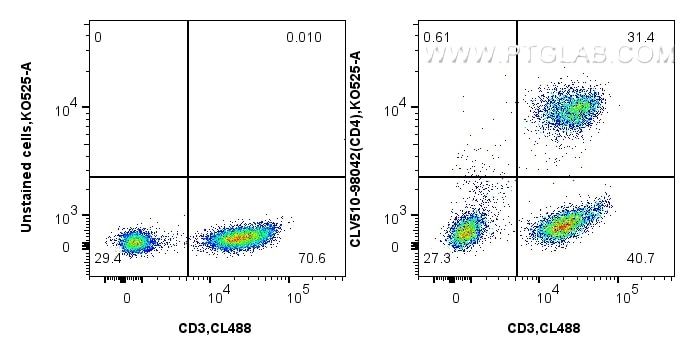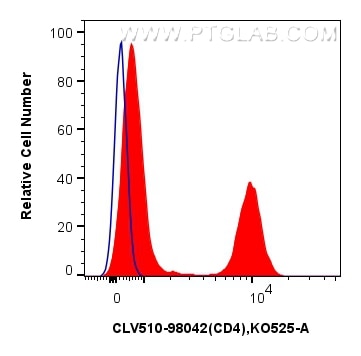CD4 Rekombinanter Antikörper
CD4 Rekombinant Antikörper für FC
Wirt / Isotyp
Kaninchen / IgG
Getestete Reaktivität
Affe, human, nicht-humane Primaten
Anwendung
FC
Konjugation
CoraLux Violet 510 Fluorescent Dye
CloneNo.
240427E12
Kat-Nr. : CLV510-98042
Synonyme
Geprüfte Anwendungen
| Erfolgreiche Detektion in FC | humane PBMCs |
Empfohlene Verdünnung
| Anwendung | Verdünnung |
|---|---|
| This reagent has been pre-titrated and tested for flow cytometric analysis. The suggested use of this reagent is 5 ul per 10^6 cells in a 100 µl suspension or 5 ul per 100 µl of whole blood. | |
| Sample-dependent, check data in validation data gallery | |
Produktinformation
CLV510-98042 bindet in FC CD4 und zeigt Reaktivität mit Affe, human, nicht-humane Primaten
| Getestete Reaktivität | Affe, human, nicht-humane Primaten |
| Wirt / Isotyp | Kaninchen / IgG |
| Klonalität | Rekombinant |
| Typ | Antikörper |
| Immunogen | CD4 fusion protein Eg0333 |
| Vollständiger Name | CD4 molecule |
| Berechnetes Molekulargewicht | 55 kDa |
| GenBank-Zugangsnummer | BC025782 |
| Gene symbol | CD4 |
| Gene ID (NCBI) | 920 |
| Konjugation | CoraLux Violet 510 Fluorescent Dye |
| Excitation/Emission maxima wavelengths | 410 nm / 501 nm |
| Form | Liquid |
| Reinigungsmethode | Protein-A-Reinigung |
| Lagerungspuffer | PBS with 0.09% sodium azide and 0.5% BSA |
| Lagerungsbedingungen | Store at 2-8°C. Avoid exposure to light. Stable for one year after shipment. |
Hintergrundinformationen
CD4 is a 55-kDa transmembrane glycoprotein expressed on T helper cells, the majority of thymocytes, monocytes, macrophages, and dendritic cells (PMID: 9304802; 12213222). CD4 is an accessory protein for MHC class-II antigen/T-cell receptor interaction. It plays an important role in T helper cell development and activation (PMID: 9539765; 3112582). CD4 serves as a receptor for the human immunodeficiency virus (HIV) (PMID: 9304802).
Protokolle
| PRODUKTSPEZIFISCHE PROTOKOLLE | |
|---|---|
| FC protocol for CoraLux Violet 510 CD4 antibody CLV510-98042 | Download protocol |
| STANDARD-PROTOKOLLE | |
|---|---|
| Klicken Sie hier, um unsere Standardprotokolle anzuzeigen |



